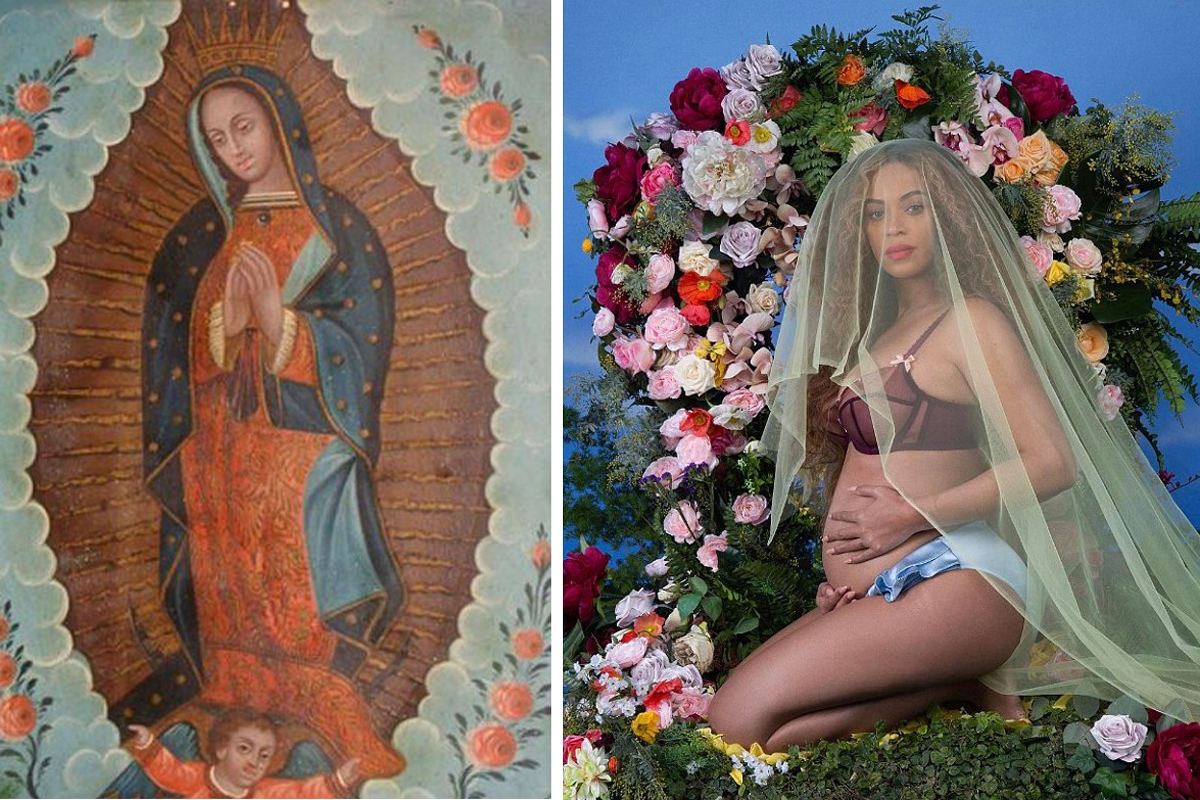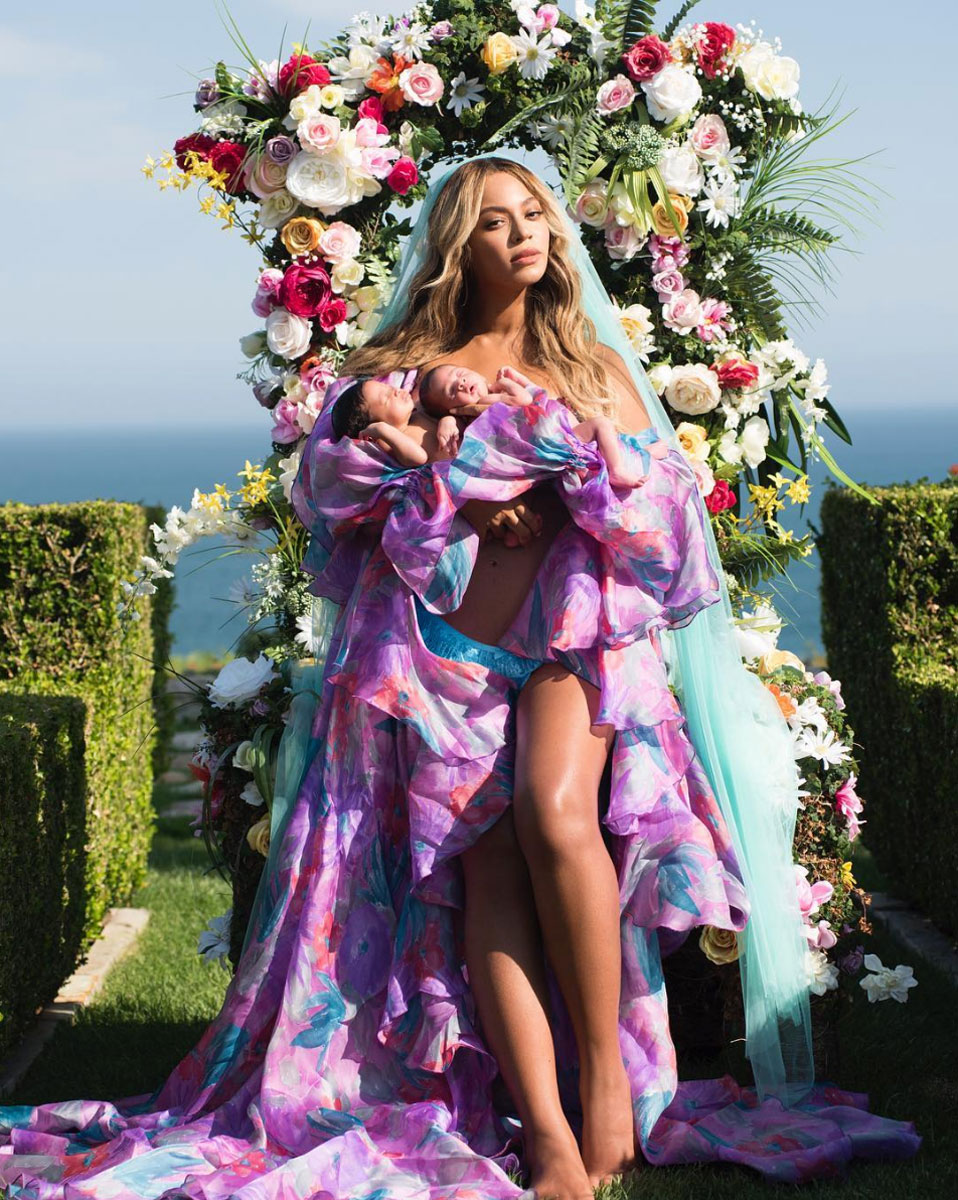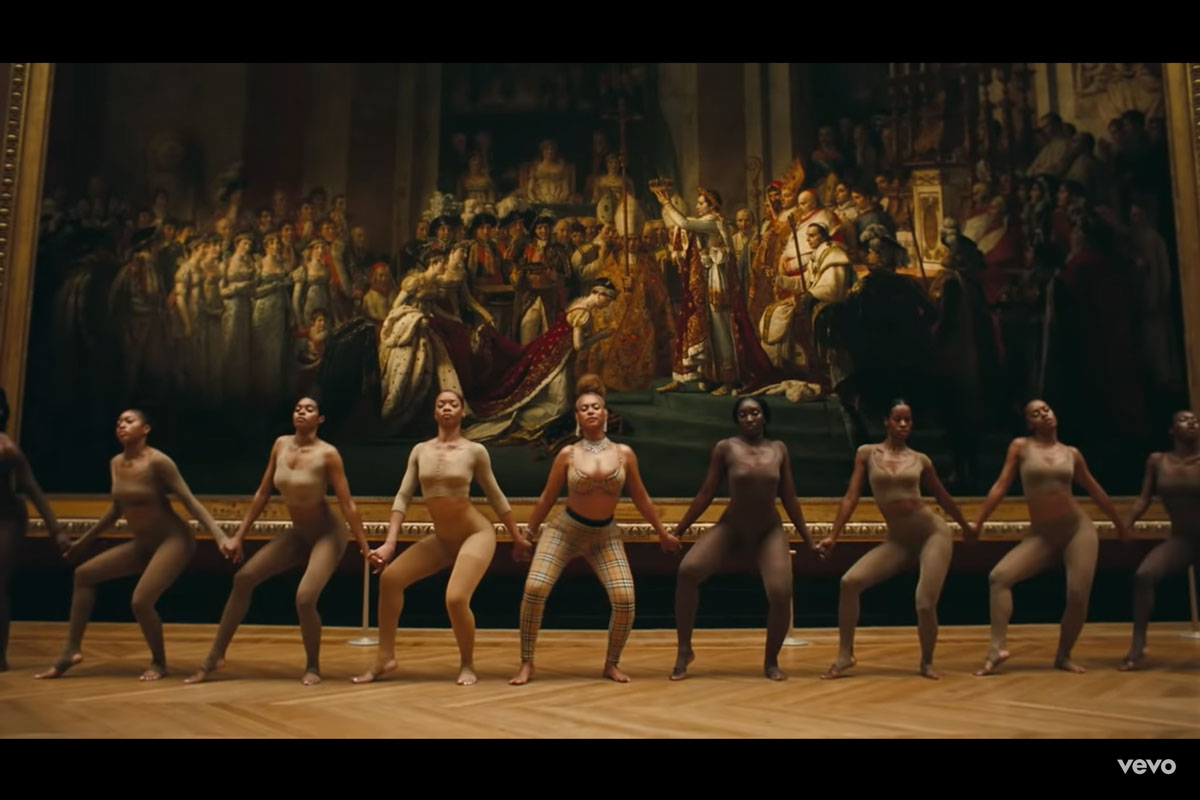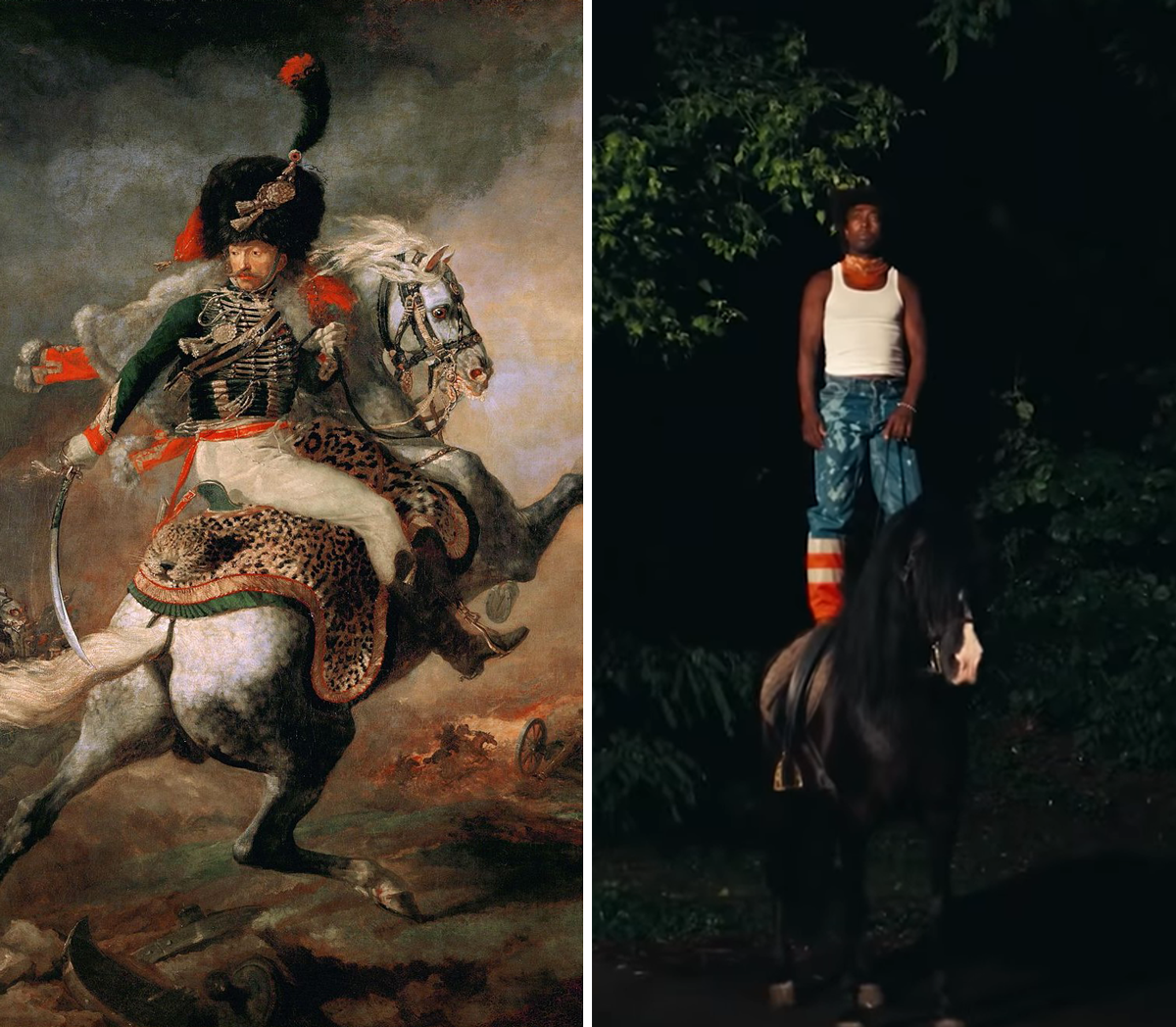32 — June 2019
Bey and Jay, or, The New Royal Hip-Hop/Pop. Beyoncé’s and Jay-Z’s Politics and Aesthetics of Self-Portrayal
Maha El Hissy
When the American singer Beyoncé and her husband, the rapper Jay-Z, realesed their joint album “Everything is Love” in June 2018, it was perceived as celebrating “renewed romantic bliss.”1 After the popstar publicly evoked grief, rage and vengeance by dint of her husband’s infidelity in her 2017 album “Lemonade,” followed by lyrics about regret and guilt in his song “4:44,” this new collaboration was advertised as a reconciliation, and was symbollically billed under the name “The Carters” – the couple’s surname by marriage. Remarkably, Bey and Jay celebrate their reconciliation through self-fashioning and self-coronation as a modern royal couple. They make their reunion public by shooting the lead single, “Apeshit,” in the monumental, grandiose Louvre museum, in a godlike performance. If the song title, meant to express anger, is instead read in terms of “aping,” it may imply that the whole setup is just an act of mimicry. The clip has even been understood as mere cultural and visual “bling.”2 On the contrary, the artistic process of self-inclusion and self-incorporation among antique sculptures, vast paintings of Biblical scenes, or renowned neo-classicist icons – where the duet overwrites and sometimes even tops and outshines the history of colonialism, slavery, or the French Revolution – is extremely purposeful, as is the choice of location, where the video was shot. The museum is housed in the Louvre Palace, which was once the main residence of French kings. Today, it boasts many of the great classics of art history by white male European painters such as Jaques-Louis David, Delacroix, Leonardo Da Vinci, and Théodore Géricault. By shooting a video in this symbolic location, Bey and Jay elevate themselves to the level of dazzlingly wealthy royal couples or omnipotent gods – more than just reconciled man and wife.
For instance, a few seconds after the beginning of the clip, a long zoom-in, accompanied by the intro, builds suspense before the camera first centers on the Mona Lisa, and then focuses for the first time on the African-American pop idols, who pose as sculptures in luxurious pastel suits and imposing jewelry: a royal portrait par excellence, appropriating Da Vinci’s iconic painting that appears as just another item decorating the wall behind the regal couple (figure 1). Modeling in a museum, the place where artwork is exhibited in order to be viewed by visitors, the Carters are now subjects, but also objects of exposure and adoration. If you want to catch a glimpse of Da Vinci’s masterpiece, one of the most visited and valuable paintings in the world, you will have to peek over Bey and Jay’s shoulder.

Celebrating the renewal of their bond, Beyoncé and Jay-Z stylize their marriage as exemplary, exactly as aristocratic husbands and wives have often done. In 1798, Georg Philipp Friedrich Freiherr von Hardenberg, author and philosopher of early German Romanticism, published the fragment collection “Faith and Love, or the King and Queen,” comprising 34 aphorisms, in which he praises King Frederick William III of Prussia and his wife Queen Louise, using them as metaphors to outline an ideal state and depicting their marriage as a shining example for the domestic relations of Prussian citizens. Under the pseudonym and pen name Novalis, Hardenberg asserts, for instance, that “the court is actually a large-scale model of a household. The great households of the state fashion themselves according to this, the small ones imitate these and so on down the line.”3 In “Apeshit,” the Black couple sings and narrates their own story of breakdown and rebirth, presenting a model of rapprochement and forgiveness – a version that remains somewhat surreal and far-fetched, however, due to its idealized inaccessibility. Their glamorous self-depiction easily outclasses Novalis’ portrayal of the role of Queen Louise, which he describes in more domestic terms; she is represented as supervising her children and organizing life at court, with little focus on her majestic nimbus.4
With regard to her status as a role-model mother, Beyoncé also staged her maternity in extensively viewed and circulated pictures, referencing mythological and religious icons. During her pregnancy and after giving birth to her twin sons, the American celebrity posed in photographs portraying her, for instance, as a new Black Madonna (figure 2, 3 and 4). In these images the black female body, often subjugated or subject to mockery, parody, and degradation, is instead ennobled as devotional, and resembles the sacred Virgin of Guadalupe.5 After giving birth, the pop luminary posed again, as a statue surrounded by a halo-like arch of flowers (figure 4), wearing a turquoise veil over her head, and a flowery gown draped across her body – surpassing even the Christian icon by being “blessed two times over,”6 as Beyoncé had announced during her pregnancy, carrying twins, not just one son. In addition to the religious implications, the picture is a statement on a modern vision of motherhood. Bey exhibits her parenthood as a woman of power, or what society desires as an ideal of the modern working mother: pretty; fresh with no signs of exhaustion; sexy and devout at the same time; immaculate, powerful, and multi-tasking. In a critical approach, after the prominent singer posted her picture on Instagram, several parents recreated the superstar’s posture, imitating or parodying it, always mocking the artsy, flawless and illusionary performance of parenthood.

Figure 3: Beyoncé’s Pregnancy (r)

On a further note, Beyonce’s and Jay-Z’s self-glorification and grandeur that touches on mythologies and deities evidently also implies questions concerning race. In fact, in the six-minute clip shot in the Louvre, their self-coronation as King and Queen introduces another spectacular scene of enthronement: “Le Sacre de Napoléon” (“The Coronation of Napoleon”, 1807) by neo-classicist painter Jacques-Louis David, portrays the ceremony of Napoleon’s coronation in Notre-Dame Cathedral in Paris in 1804 (figure 5). The painting, commissioned by the French Emperor himself, was obviously an act of self-coronation as well, albeit in the literal sense of the word.7 The juxtaposition of Beyoncé’s and Jay-Z’s singing, the performance by the accompanying female dancers of color, and David’s painting in the background opens up a space for readings that go beyond the historic ceremony of this specific coronation in the Cathedral. David’s work depicts Joséphine de Beauharnais, Napoleon’s first wife, kneeling in front of her husband to receive the crown from him. Their marriage was also marked by infidelity. But even more important is the history of expansion, colonialism, invasion and slavery that Napoleon stands for. After the abolition of slavery during the French Revolution, the law of 20 May 1802, under Napoleon’s rule as consul, reinstituted slavery in the French colonies. Accordingly, the song’s refrain “I can’t believe we made it” refers not only to marital reconciliation but to the history of Black emancipation and empowerment, upward social mobility and wealth, embodied by one of the richest couples in the music business.

The reference to slavery is made even more explicit when Jay begins his solo in the video, shortly after minute three. After we hear Beyoncé singing the refrain, several successive shots first show the rapper looking at the icon of French Romanticism, “Le Radeau de la Méduse” (“The Raft of the Medusa”, 1819) by the pioneer of the Romantic movement, Géricault. The painting reopens an old wound by bringing to life the shipwreck of the frigate Méduse in 1816, a memory that was meant to be buried in oblivion.8 One of the most significant and controversial aspects of Géricault’s painting was certainly the fact that he placed a black man at the pinnacle of the image, depicting a black hero leading 15 white survivors, which can be understood as support of the abolitionist movement. In a following shot, the camera pans to show an earlier picture by the same painter: “Officier de chasseurs à cheval de la garde impériale chargeant” (“The Charging Chasseur”, 1812), which portrays a Napoleonic cavalry officer mounted and dressed in full uniform (figure 6). What is more interesting is the twist that follows in the subsequent shot (figure 7). It shows a Black man standing erect, simulating a statue by standing on the back of a horse, in what seems to be a comic twist on scenes of colonial battle and conquest. Everything formal, that was a symbol for conflict, quarrel and defeat is set aside. Instead, being chilled-out and laid-back stands as the new version of sovereignty, Black sovereignty.

Figure 7: Apeshit: Black Man Posing on Horseback (r)
It is interesting to note that Beyoncé’s and Jay’s famous shoot at the Louvre was perceived as an event with miraculous effects. On the one hand, several reports ascribed a rise of the number of visitors in 2018 to the couple’s performance. As the museum’s director, Jean-Luc Martinez, stated in a French radio interview: “The Beyoncé video, like the opening of the Louvre museum in Abu Dhabi, ensured that the Louvre was talked about across the world, and one of the consequences of that is the spectacular rise in visitor numbers last year.”9 On the other hand, the shoot was criticized for opening up a setting meant for high art to “phenomena of the pop culture industry.”10 It suggests an objection to subjugating everything to capital. “Money can’t buy me high art” is the new “Money can’t buy me love”. However, it is also worth asking to what extent this objection specifically targets the rise of a new Black elite, a Black dynasty.
Notes
- 1Alexis Petridis, “The Carters: Everything Is Love review – Beyoncé and Jay-Z celebrate their marriage and magnificence”: https://www.theguardian.com/music/2018/jun/17/the-carters-everything-is-love-review-beyonce-jay-z
- 2“Die Pop-Götter im Kunst-Olymp. Henry Keazor im Gespräch mit Shanli Anwar”: https://www.deutschlandfunkkultur.de/beyonce-und-jay-z-drehen-im-louvre-die-pop-goetter-im-kunst.2156.de.html?dram:article_id=420675 (last accessed on 12 June 2019).
- 3Novalis (1997), “Faith and Love or The King and The Queen,” in: Philosophical Writings, translated and edited by Margaret Mahony Stoljar. Albany: State University of New York Press, p. 91.
- 4Ibid, p. 90.
- 5It is said that the Virgin Mary appeared to Juan Diego (1474-1548), a native of Mexico, on four different occasions at the Hill of Tepeyac, which is now a part of the Villa de Guadalupe in Mexico. She commanded Juan to bring her flowers. It was said that an imprint of Mary’s likeness later appeared on Juan’s cloak, where he had collected the flowers. For more on the Virgin of Guadalupe see: Małgorzata Oleszkiewicz-Peralba (2007), The Black Madonna in Latin America and Europe. Tradition and Transformation. Albuquerque: University of New Mexico Press.
- 6See https://www.instagram.com/p/BP-rXUGBPJa/
- 7Receiving the crown, which was usually carried out by the pope as a mediator between God and the King, was replaced by Napoleon placing the crown on his own head. After the concordat of 1801, an agreement between Napoleon and Pope Pius VII, a reconciliation was achieved between the political and religious powers after years of discord and war in the aftermath of the French Revolution. Most of the rights of the Roman Catholic Church were restored. However, it was subordinate to Napoleon’s power.
- 8The French captain was blamed for the ship’s sinking, and it was said that the survivors had to practice cannibalism to survive starvation.
- 9Qtd. after: Angelique Chrisafis. “Beyoncé and Jay-Z help Louvre museum break visitor record in 2018” (last accessed on 12 June 2019)
- 10Saskia Trebing: Beyoncé und Jay-Z im Louvre. Eine neue, moderne Dynastie, https://www.monopol-magazin.de/eine-neue-moderne-dynastie (last accessed on 12 June 2019)
